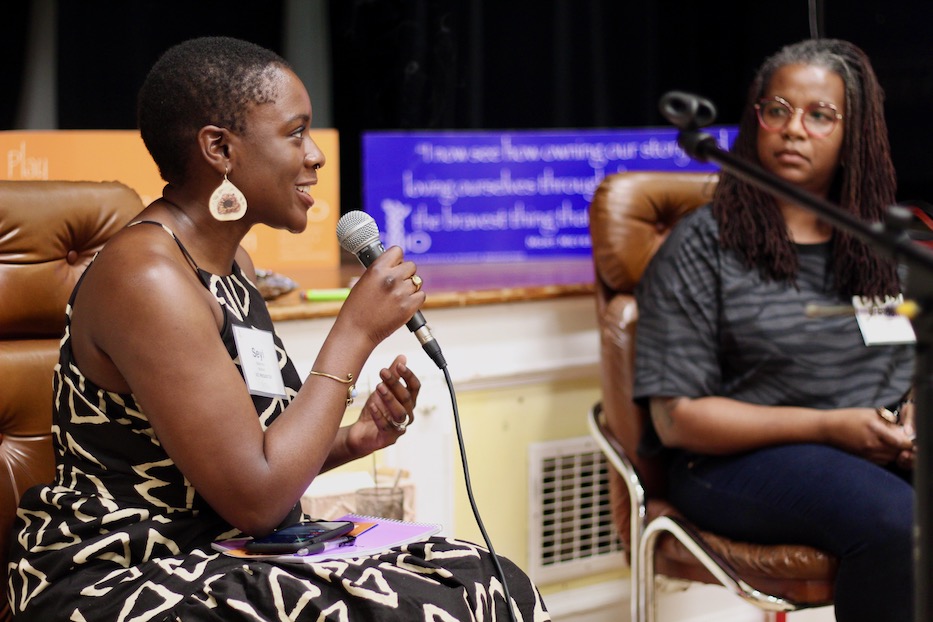
Culture & Community | Arts & Culture | Whitneyville | Arts & Anti-racism | CEIO
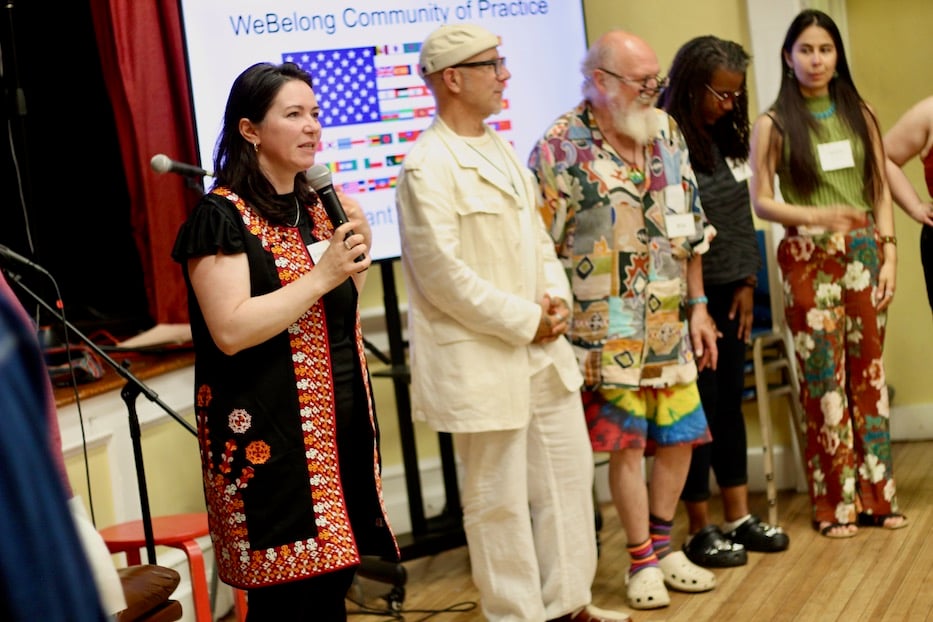
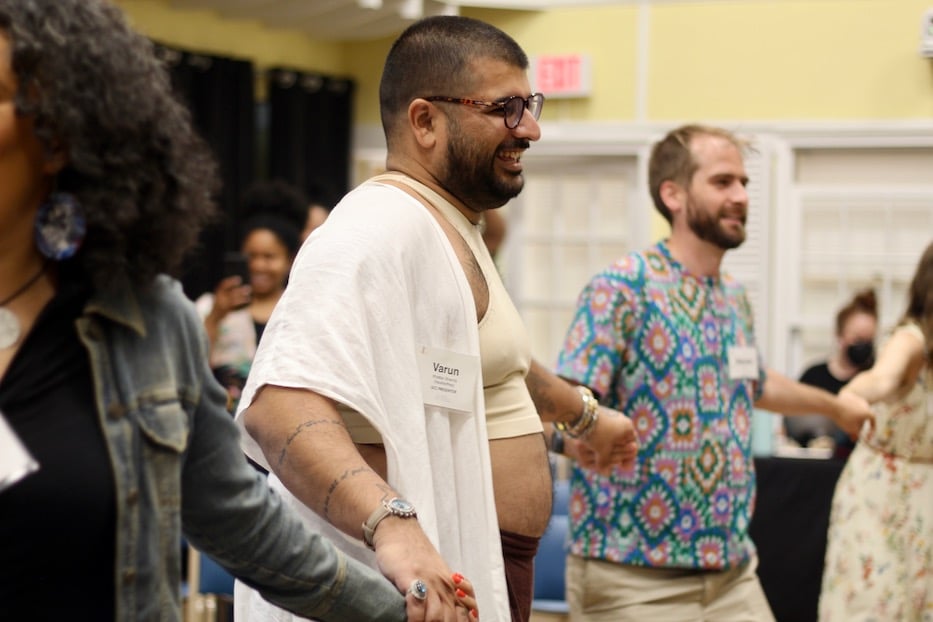
Top: Armela Waters: “If each of us can take an action,” the weight of social justice will not seem quite so heavy. Bottom: Varun Khattar Sharma, the brain behind the Hartford-based People’s Saturday School. Lucy Gellman Photos.
Across the Whitneyville Cultural Commons, dozens of hands linked one by one, palm joining palm in that intimate gesture of trust. As the first strains of Albanian music floated into the air, Armela Waters kicked one leg into the air, and then followed it with the other. She beamed and looked across the room, watching as a long-held vision came to life before her eyes.
Water's “WeBelong,” a community of immigrant mothers, is among over a dozen visions for a more equitable, liberatory and anti-racist future Co-Creating Effective and Inclusive Solutions’ (CEIO) second annual Seeding Conscious Co-Creation (SCC) cohort, a group of 17 "vision holders" who have all received funding to build and pilot new projects centering social justice. On a recent Friday, all 17 gathered with friends, families and community members at the Whitneyville Cultural Commons in Hamden to present their work.
This year’s projects include grassroots arts initiatives, tight-knit support groups, anti-racist storytelling on the Connecticut Shoreline, and movements for joy and justice among sex workers.
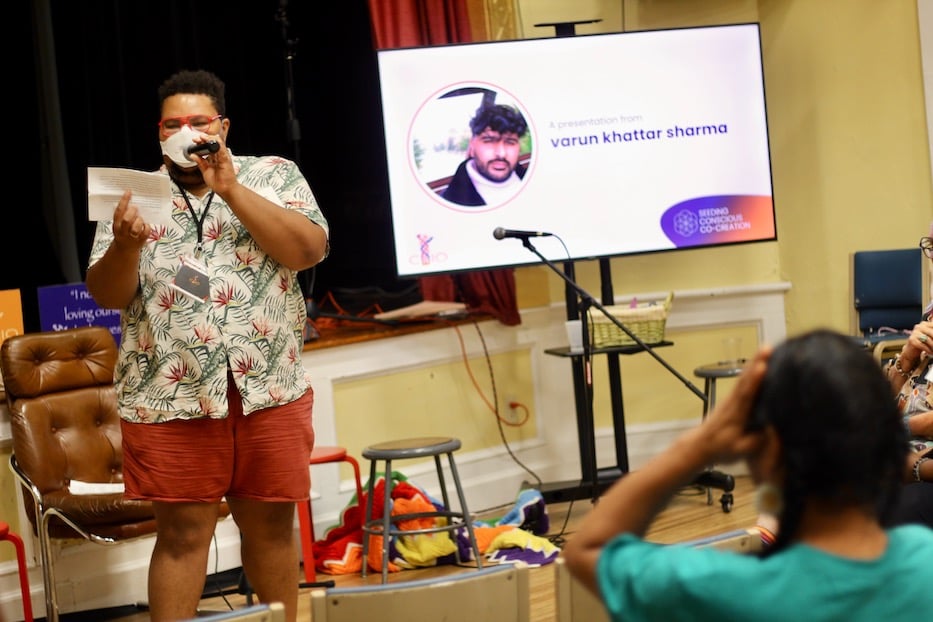
CEIO's Farron Harvey introducing some of the afternoon's presentations.
"The main intention is to open doors to equity, justice and liberation," said SCC Director Slate Liu-Ballard, who leads the program alongside Associate Director Leyanne Oliveira. "Who are you in relationship with? Who are the people that you are in community with?"
The program, now in its second year, spends 10 months asking those questions. From October through May, cohort members meet each month, with an opening retreat weekend and closing presentation. Through the program, each receives funding to help bring their project or vision to life. Some are collaborative, or intersect and overlap in their mission: learn more about each project here.
By last month, each formed a “community of practice” meant to support and grow their initial vision. Speaking early in the day, SCC members Brandon Hutchinson and Seyi Adeyinka each spoke about their projects, respectively called "Sister Let's Let Go" and "Nurture," giving attendees a sense of the learning they would be doing over the course of the day.
While both live and work in the region, they noted that they’d not met before the program, pointing to its ability to bring people together.
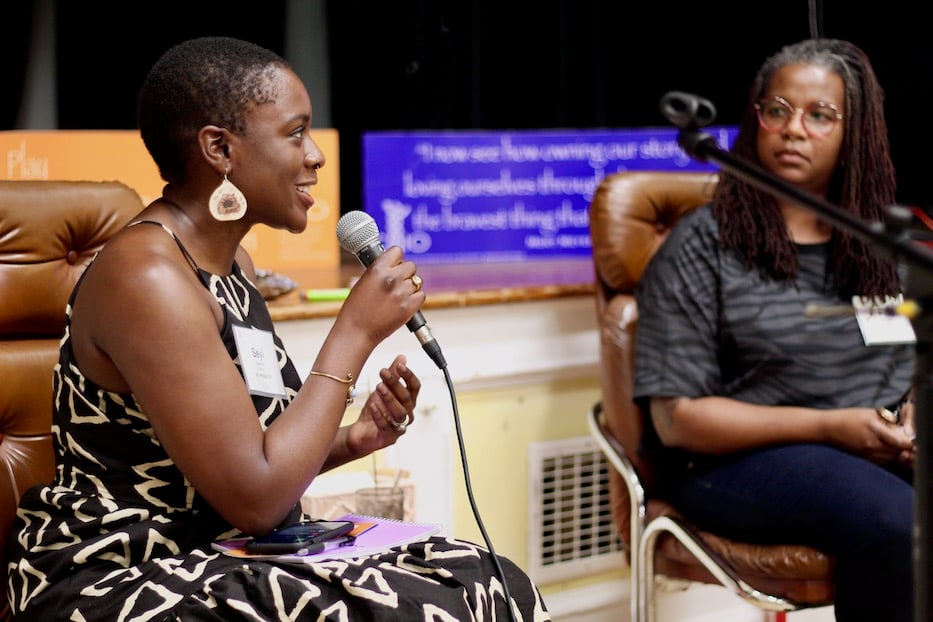
Seyi Adeyinka and Brandon Hutchinson.
To Beautiful Chorus' "Bless Up," the two set an ancestral altar, lighting candles that flickered from the stage long after their conversation had ended. Hutchinson, who is a parent, an award-winning professor in the English department at Southern Connecticut State University (SCSU), and a poet, noted that for years, she’d felt like an imposter as she moved through the world. "Sister Let's Let Go" was the answer to that gnawing sense of not being enough.
"[It is] a practice that I needed for myself," she said. "I was having a hard time giving myself grace."
For Adeyinka, a resident in psychiatry at the Yale School of Medicine, that sense of being stretched to the point of exhaustion resonated deeply. As a Black woman in her line of work, she was already caught in a healthcare system plagued with high burnout, in a profession that for centuries had excluded people that looked like her. Demand in her field, meanwhile, has surged, exacerbated largely by the pandemic. She began to make art as a social practice, and found that it helped her reconnect with herself.
Recently, she said, she's been asking herself the question: "How can I be softer with myself? Her time with SCC helped her think about the answers, from intentional rest to connecting more frequently with people who work outside of the mental health profession. She joked that she now thinks of every space as a potential community of practice, including within her residency.
"There's a lot of unlearning for women of color, and anyone operating in a system," she said. "I'm seeing that I am changing. My seed is changing. And I'm bringing that to everywhere I am."
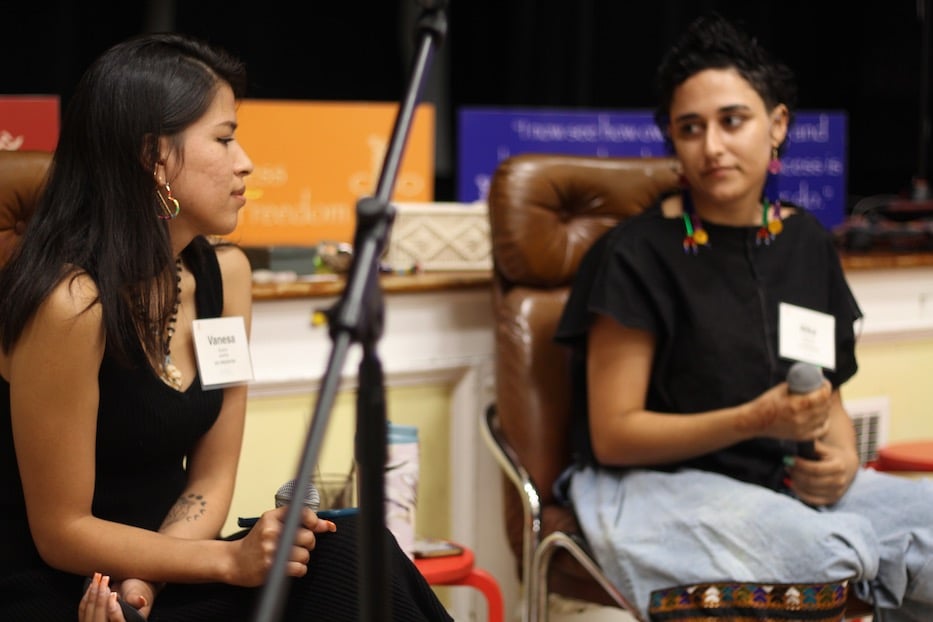
Vanesa Suarez and Nika Zarazvand. “Crisis doesn’t stop just because I don’t want to focus on it,” Zarazvand said. “It is literally in favor of everybody’s humanity that we fight for this.”
That learning and unlearning echoed throughout the day, as presentations wove through the morning and into the mid-afternoon. From a collaborative space for creative business owners of color to a cooking initiative meant to bring community together, each of SCC's participants came to the stage with a framing of a world that could be, rather than the world that is.
Presenting just days after a rally demanding justice for Roya Mohammadi in West Haven, organizers and artists Vanesa Suarez and Nika Zarazvand imagined a world free of violence toward women, drawing largely from the Indigenous Zapatista women that Suarez has learned from and documented in Chiapas, Mexico for the past several years.
For Zarazvand, who began the presentation with a grounding exercise, that means “reimagining freedom” itself, particularly in a system in which white supremacy, patriarchy, and capitalism are all bound to each other. When they and Suarez began SCC, they imagined a space “free from crisis,” where organizers could find rest and community with each other to recharge before continuing to fight.
But the crisis was all around them: women across the country, including in Connecticut, were dying from gender-based violence. Nationally, the Bureau of Justice Statistics estimates that over three women are killed each day in the United States as a consequence of domestic abuse and intimate partner violence. Between 2001 and 2021, that has included 309 people in Connecticut alone. Eighty-six percent of them were women, and most of those women were under 45 years old.
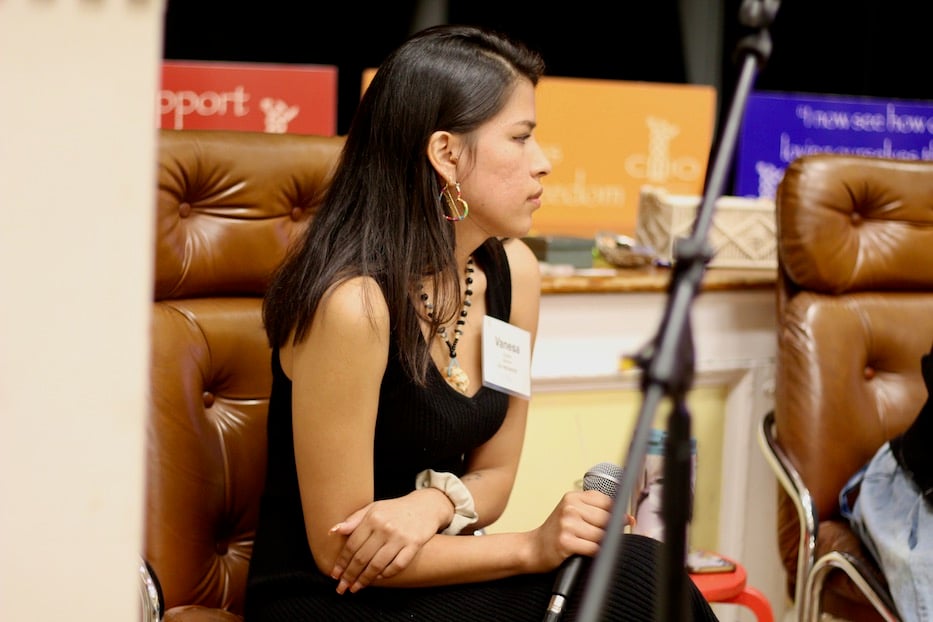
As Zarazvand spoke, they invoked the names of Mohammadi, an Afghan refugee who was found dead in West Haven on March 3, as well as Bridgeport’s Lauren Smith-Fields and East Haven’s Lizzbeth Aleman Popoca. All of them were women of color living in the state; two were immigrants. All had friends and family that had to fight for police to continue investigating their deaths. Mohammadi, who colleagues reported missing in March, had reported a history of violence at the home where she was living with an aunt and uncle.
“Crisis doesn’t stop just because I don’t want to focus on it,” Zarazvand said. “It is literally in favor of everybody’s humanity that we fight for this.”
What that looks like in real time, they and Suarez said, is a community of practice in which they speak more openly and more often about the prevalence of femicide, believe survivors, and stand up for women “in all conditions,” no matter what their migration status, socioeconomic background, or lived experience may be.
Both also pointed to the violence that borders, themselves a byproduct of colonialism, have inflicted on migrant women and families across the globe.
“This is real,” Suarez said. “We can work towards this. We can demand this. We have been taught to normalize so much violence … It takes real courage and immense hope to imagine a world free of violence. It requires you to treat women as sacred.”
“I Have Been In Hiding … Hiding From Myself And Others”
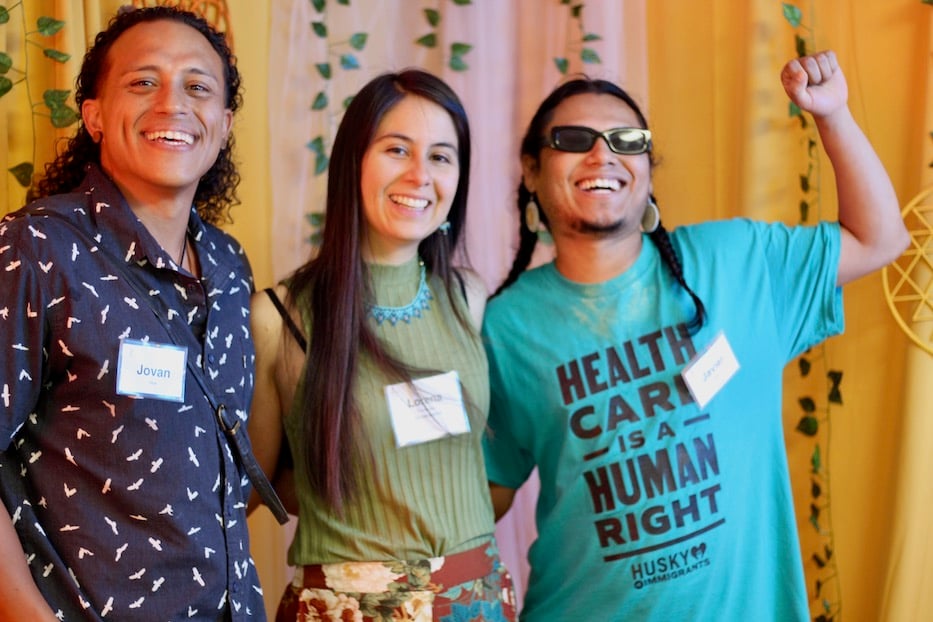
Lorena Fernandez (at center): “This community of practice is part of this furnace that I wish to feed,” she said. “This community is a space for healing.”
The words became a springboard for several of the day’s presenters, who amplified the importance of listening to voices that have often been relegated to the margins. A graduate student in clinical mental health counseling at the University of Bridgeport, Lorena Fernandez introduced “Kinship in Mental Health,” a new initiative that brings a whole-person approach into mental health work—including and especially for its practitioners.
“I have been in hiding,” she began, fighting back tears that ultimately came as a colleague helped her sage herself and the surrounding space. “Hiding from myself and from others.”
Fernandez brought it back to her youth in Greenwich and Stamford, where she was raised by two parents who were Paraguayan immigrants. Her childhood was perhaps unconventional, she said: she grew up in the homes of people for whom her parents worked, or as she said at the time. It instilled her with the sense that her family, proximate to but not a part of that whiteness and wealth, was somehow inferior. “I only realized later that it was a myth,” she said.
It wasn’t through her education at Wesleyan or the University of Bridgeport that she came to that realization, she added—it was through the power of hearing and telling personal stories. As a kid, she was surrounded with so much white supremacy that she internalized it. Her first step in healing was recognizing that “oppressor within us,” and beginning to let it go to survive.
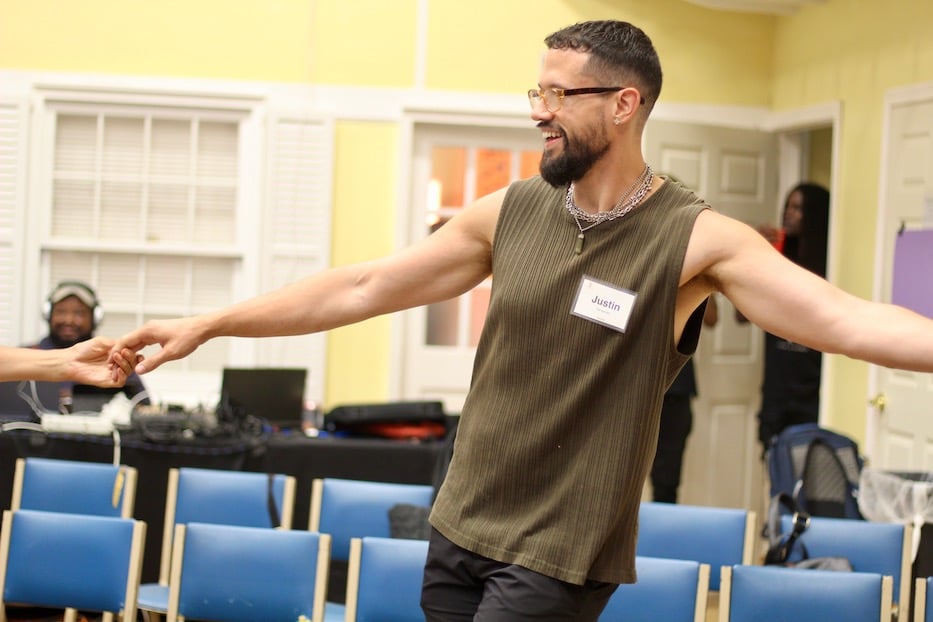
Justin Hernandez, who is working with Loren Jefferson.
In the process, Fernandez said, she’s also realized that she has a lot of anger. For her, Kinship in Mental Health is a place to address and begin to mend that, in part by reconnecting with Indigenous customs from which she long felt severed. As she builds it, she hopes “to decolonize the mainstream handling of mental health care,” which often does not emphasize the connection between land, mind, body, spirit and narrative or story.
“This community of practice is part of this furnace that I wish to feed,” she said. “This community is a space for healing.”
“What’s alive in you right now?” she added a few minutes later, asking attendees to close their eyes and verbalize what they were feeling. The room began to fill with sound, as humming joined a few bursts of noise, from deep, sonorous breaths to swooping vocals that were nearly bird-like.
Many of the projects came with a similar interactive component, from members of JoAnne Wilcox’s “Circles of Care” to a lunch spread meant to reflect the diversity of New Haven. Speaking mid-morning, Wilcox kept her own remarks short, turning the presentation over to several people who had participated in her circles.
Mark Wilson, who met Wilcox when he was five and grew up with her son, remembered coming to a circle for the first time as a way to move through and process his trauma. As a child, “growing up in the neighborhood where I grew up, it wasn’t the best,” he said.
The first time he came to a circle—a tight-knit, intergenerational support group that has made space for bereaved peers and relatives, adults in crisis, — “it was incredible,” Wilson remembered. He described it as church-like, helping him get “that gunk out from under us.”
A “New Haven Mixed Plate”
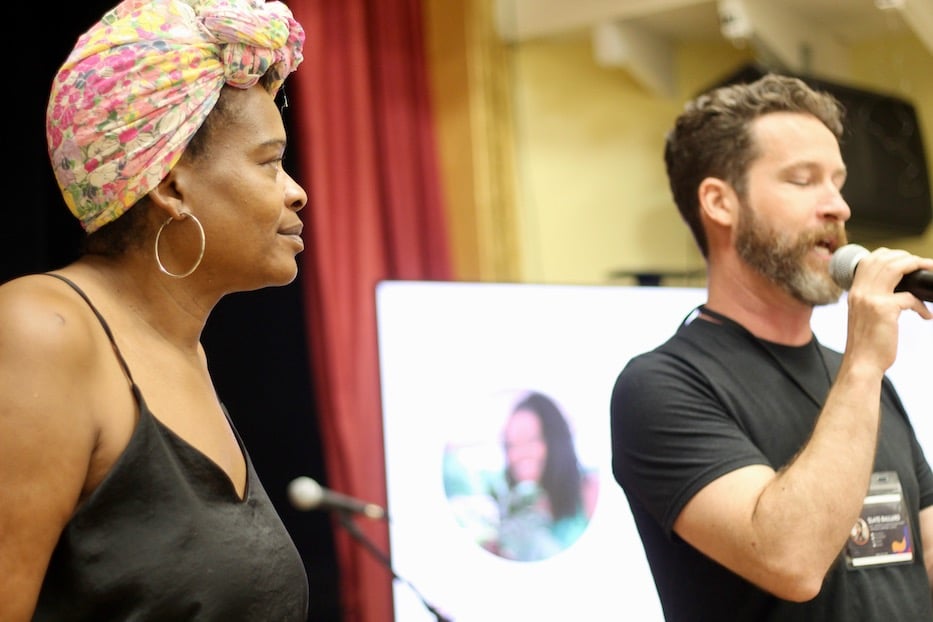
Nadine Nelson and Slate Liu-Ballard.
When she took the floor to describe Master Cook Corps, chef Nadine Nelson invited attendees to eat their way through her project, a feast that waited in the basement of the Whitney Humanities Center. The concept, which she initially referred to as soul food griots, came out of a request she often received for large, free or highly subsidized cooking classes.
“We live in a very segregated world,” she said. And yet, she found that people could connect “through food and through culture.” While her work is not new—Nelson has been creating community around food for decades she has been able to build that work with the support of SCC. Friday, she presented a “New Haven mixed plate,” or a lunch with multiple entrees sharing the same dish.
As she was building the New Haven mixed plate, she said, she considered the flavors that bloom into being across the city, from Jamaican spice and curry to pickled beets and ginger-and-jeotgal flecked vegetables . While she could not find Indigenous Quinnipiac or Wappinger recipes, she made a Lenape-inspired berry juice, sweetened naturally with maple syrup.
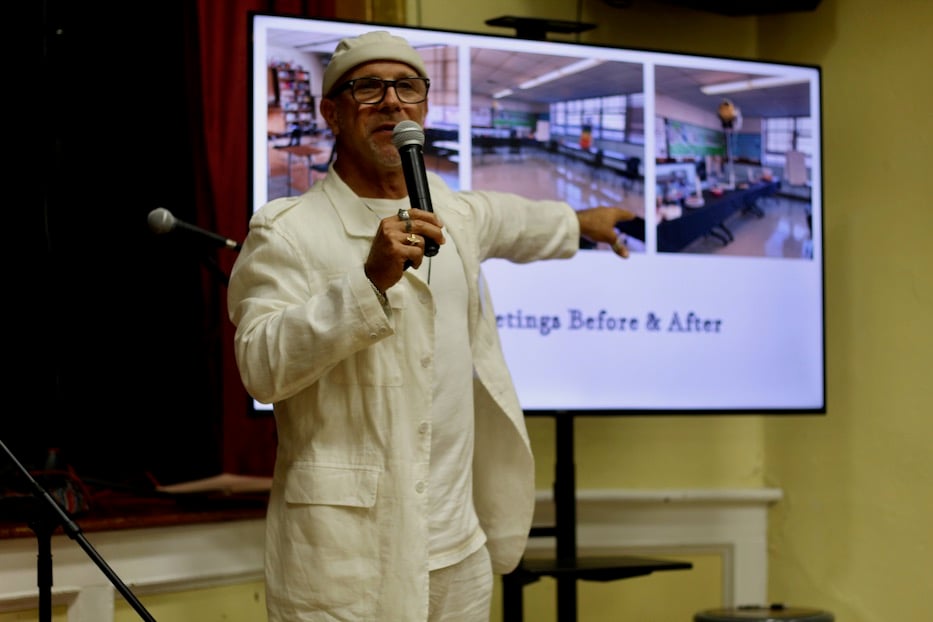
Stephen Mikolike, who is working to "build trust amongst staff and staff and students at Pathways Academy."
Downstairs, participants could experience that in real time, as they filled their plates with different bean, black-eyed pea, corn and pasta salads, a Gochugaru-kissed cabbage slaw, beef kofta and chicken with a thick, colorful coating of spice that nearly shone in the light. As they gravitated toward tables, Nelson directed them to questions such as “Which cuisine have you always wanted to try?” and “How do you think the cultural diversity of New Haven has influenced its food scene?”
That was also true for Waters, an immigrant mom herself who helped wake attendees up after lunch with communal dancing. Before she founded WeBelong, she remembered, she was in the corporate workplace for decades, only to find that she was constantly worn down by a culture of white supremacy and racism that ultimately drove her from the field. While she had once believed that “assimilating into whiteness” held the answers, she realized it did not after breaking down one day at work.
“How many of you have quit a toxic environment or relationship?” she asked. Two dozen hands instantly went up across the room. “We’re here!”
As she returned to herself, she said, she realized that connecting with other immigrant and refugee mothers was a source of both comfort and power. The more moms she talked to, the more “we shared the feeling of not fully belonging to the U.S. or to our own cultures,” she said. Since, WeBelong has grown into a series of sessions, at one of which she led communal folk dancing. It gave her the idea for Friday’s opener.
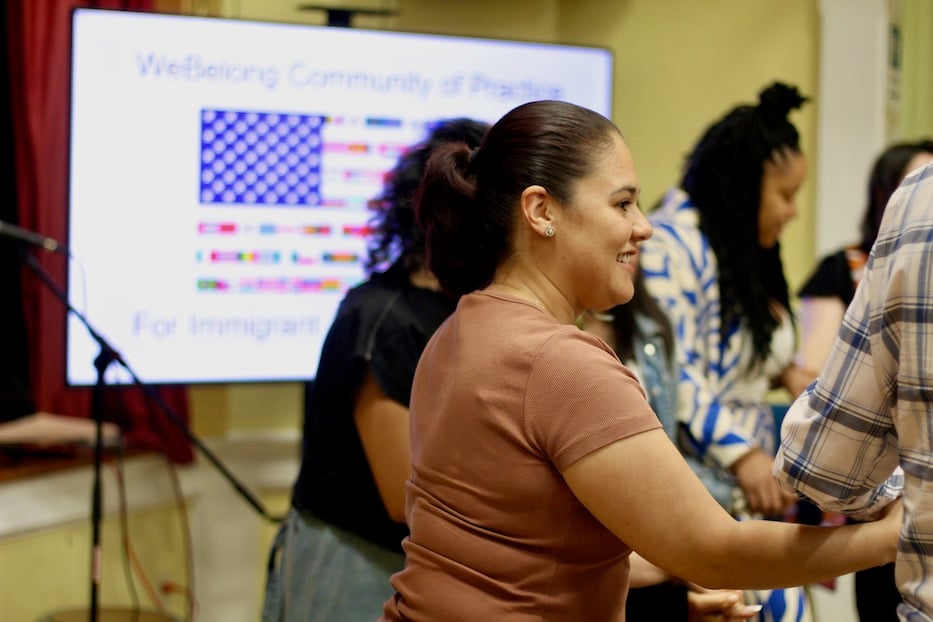
Participants in Armela Waters' folk dance, which she led after lunch.
She said that she also has thought about how to bring the group’s work into organizing for a better social safety net, in which basic human needs like housing, healthcare, jobs, and safety from domestic violence don’t seem like so much to ask. “If each of us can take an action,” the weight of social justice will not seem quite so heavy, she said. She thanked Suarez and Zarazvand for their work before she concluded.
Others looked to work that they had been doing for years, and imagined better and more equitable models of that work with the help of CEIO and SCC. After years of working as an artist and art therapist, SCC participant Briah Luckey founded “Liberation Spark Practice,” which invites fellow white women to unlearn racism through artmaking and visual journaling.
Varun Khattar Sharma, who is the brain behind the Hartford-based People’s Saturday School, took their need for a better path to education, and founded a worker cooperative focused on building community.
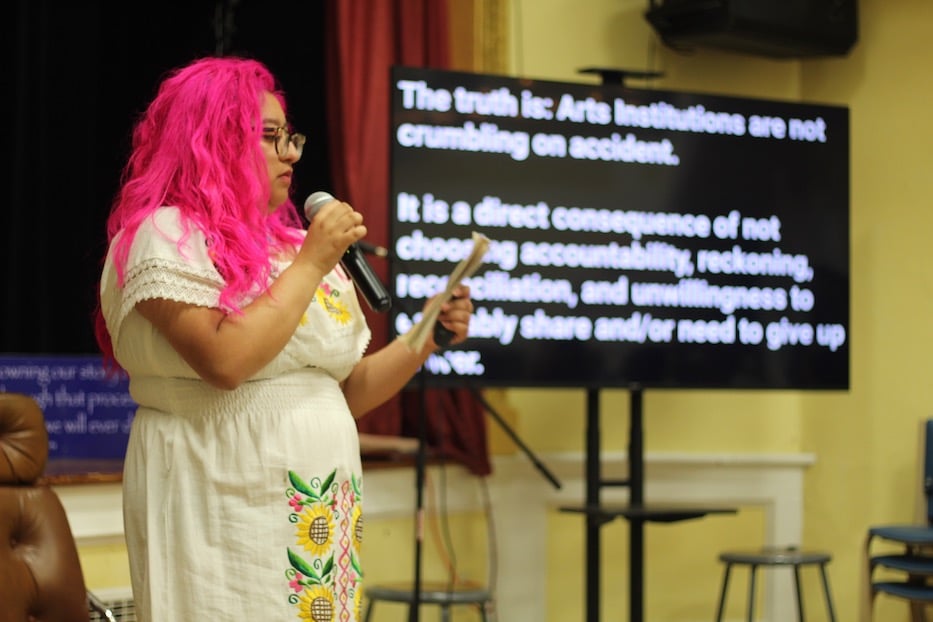
Artist Ruby Gonzalez Hernandez.
Artist Ruby Gonzalez Hernandez, who earlier this year curated Tierra at the Fair Haven Branch Library, described the process of founding Fair-Side after years of experiencing the city’s well-heeled arts institutions ask artists for time and labor without proper credit or compensation. The longer she was in it, she said, the more she wanted to build a space that existed outside of it.
Enter Fair-Side, a community of practice dedicated to artists and artmaking outside of capitalism or expectation of a final product. In addition to Tierra, the initiative’s first show, Gonzalez Hernandez pointed to Parallel Play, a semi-monthly group that she leads where artists can simply show up and create.
As she watches major and overdue transitions in the city’s art scene—the closure of Artspace, a board shakeup at the Ely Center of Contemporary Art, a new director at Creative Arts Workshop—she’s glad to have an alternative.
“Community is safety to me,” she said, peppering her presentation with slides of cats to keep it upbeat, even when the subject matter got heavy. “Community is having trust and the ability to say if something is not okay. Fair-Side requires artists to be in the center. I literally want artists to be able to be in community with each other without the need to buy in.”
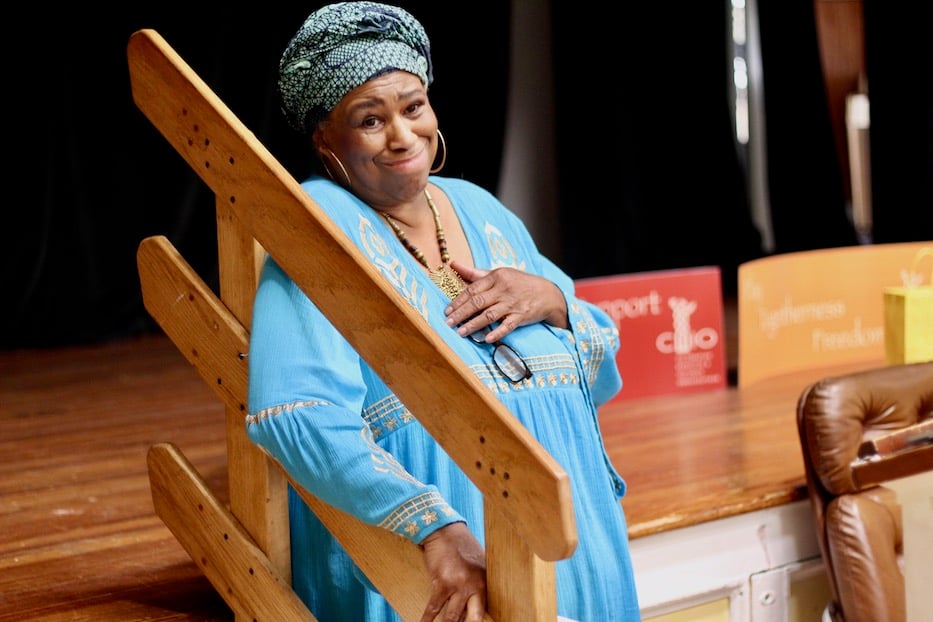
Storyteller Denise Page, who leads Indaba Storytellers with Merle Harrison.
In under a year, she said, she’s learned the power of trusting in her own vision. With fellow artist and singer/songwriter Briana Williams, Gonzalez Hernandez is planning an “Artists’ State of the Union” to address the needs and hopes of artists in New Haven, particularly those who have been pushed to the sidelines because they are nonwhite, not wealthy, or do not come with enough perceived cultural caché.
Longtime DJ Loren Jefferson, who since 2021 has run WineDown CT with Thema Haida, spoke about her launch of “Curators of the Culture” and the Disruptive Marketing Agency, a still-nascent firm “catering to the needs of the people that we were creating for.”
Since she began SCC last year, she said, it has become clear to her how much the city needs a collaborative—rather than competitive—space for creators of color. The first Curators of the Culture event took place in late March of this year at the Westville-based small business BLOOM.
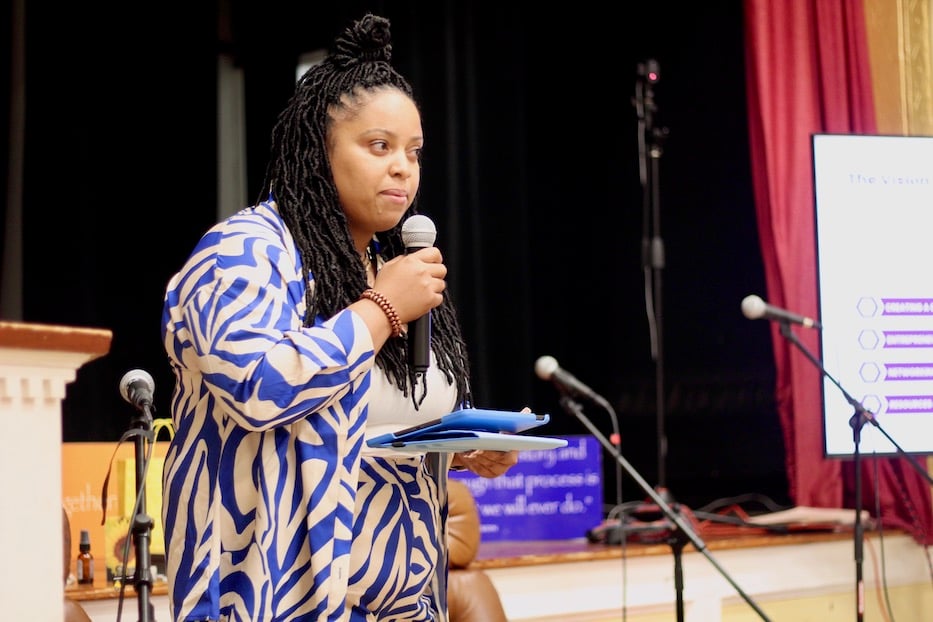
Loren Jefferson.
“When we work together, we can build together and nobody loses,” she said, pointing out collaborators Haida and Justin Hernandez in the audience. “If you build with love, then you can’t lose.”
Part of that work has been informed by her own lived experience, Jefferson added. For years, she told her mom that she planned to be a professional DJ, and got used to hearing the response “Okay, but when are you going to get a real job?” Each time the conversation played itself out, she realized that she needed a community of people who felt the same way—and wanted to turn their creative work into their full-time work.
Now, she thinks about entering rooms to Jill Scott and Lupe Fiasco’s “Daydreamin,” part of a sign that she is in the midst of achieving a personal dream. In the fall, she plans to hold another event for Black and Brown entrepreneurs, with a date and location that are yet to be announced.
Learn more about CEIO at the organization's website.

